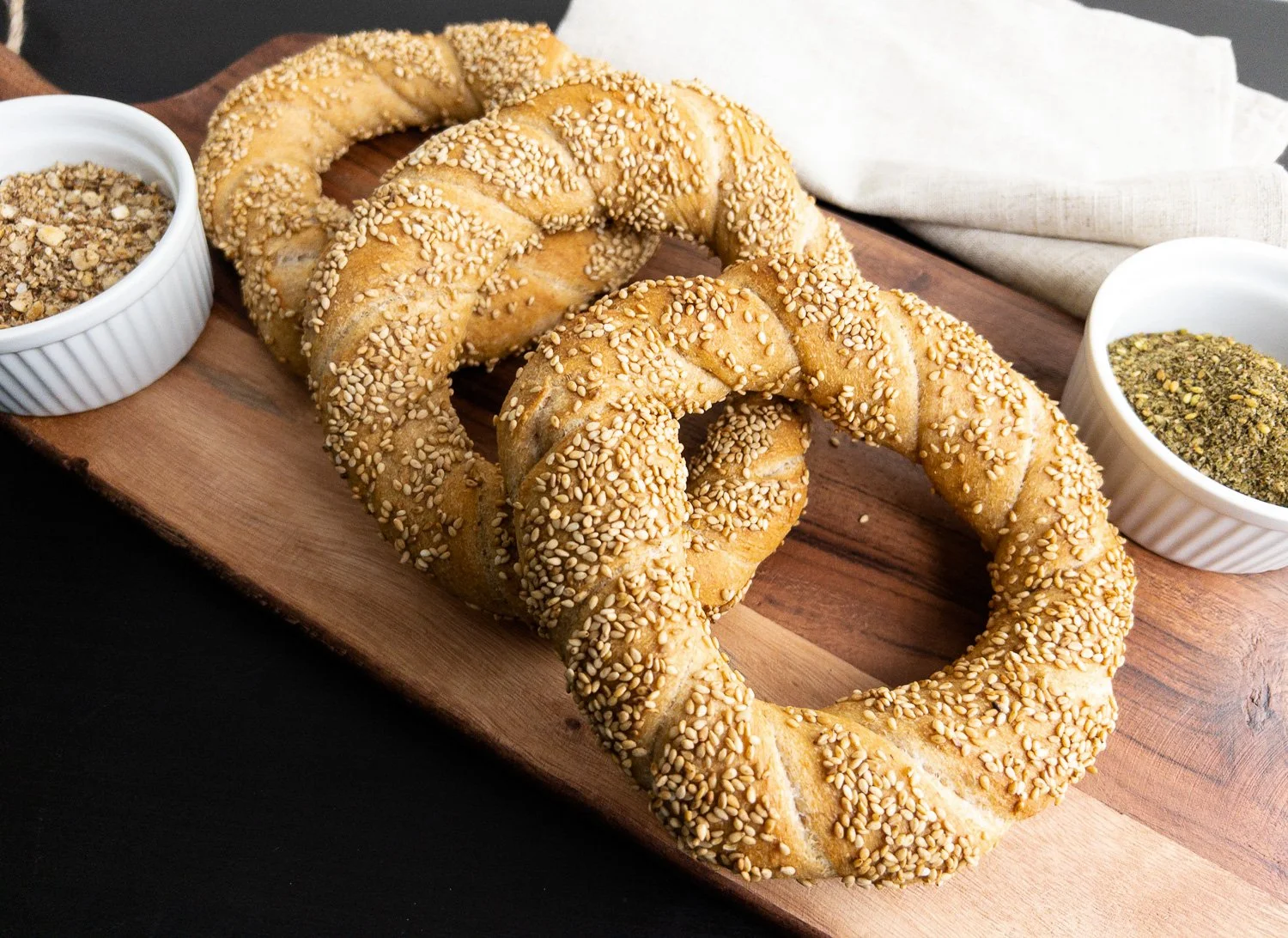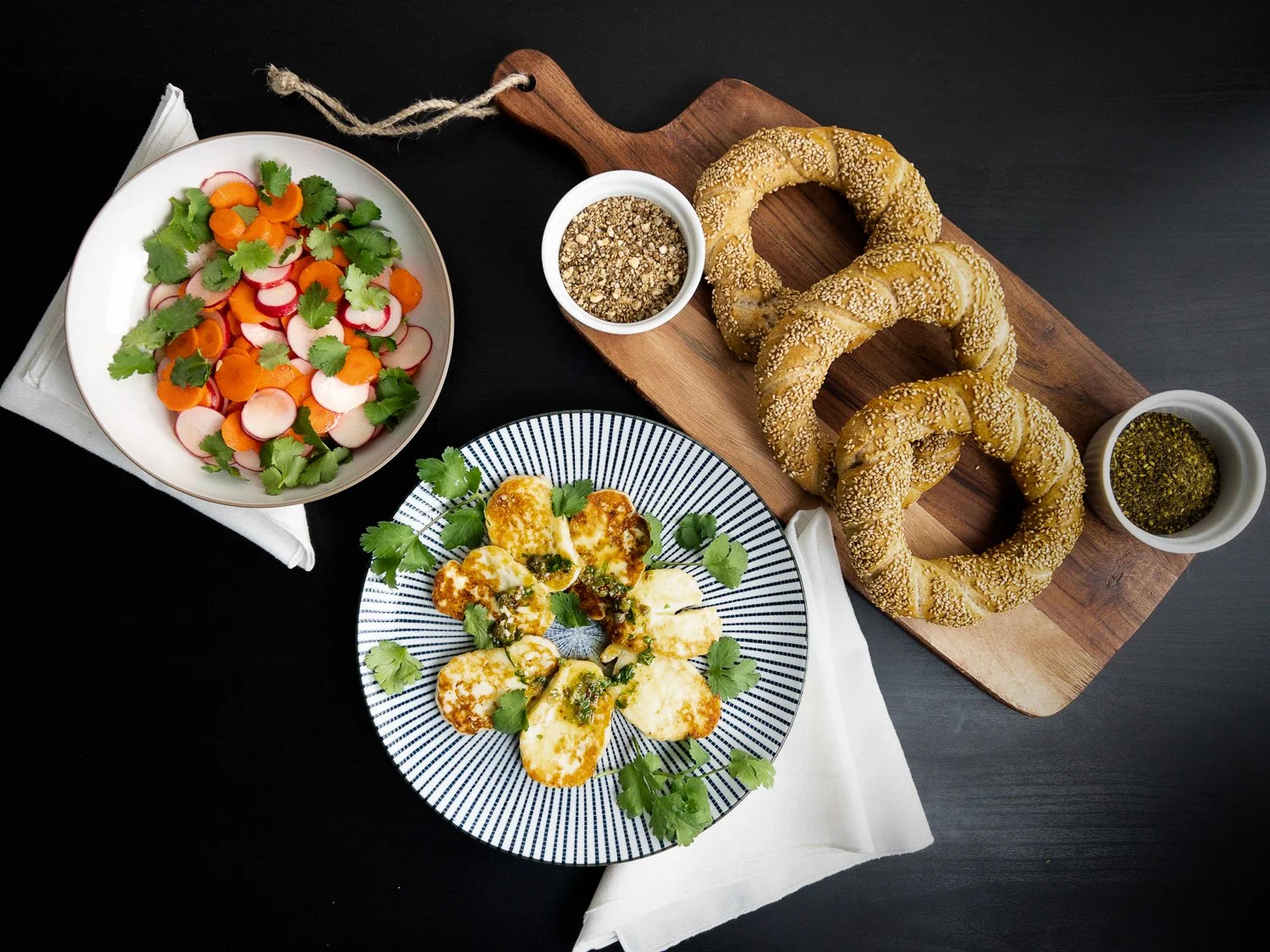Sesame Sourdough Simit
Simit are a circular bread commonly encrusted in sesame seeds, found all over the Middle East. Apparently they are commonly referred to as “Turkish bagels” in the U.S., but I’ll be honest, I hadn’t heard of them until I read through ‘The New Book of Middle Eastern Food’ by Claudia Roden where she refers to them being sold in the markets of Cairo “along with zaatar or do’a to dip them in”. I was intrigued and sought out a recipe I could use my sourdough starter in. If you don’t have or want to use a sourdough starter, here is a recipe from King Arthur (who I generally trust, though I have not tried this recipe myself): Turkish Simit from King Arthur Baking.
These beauties turned out to be chewy, crunchy, flavorful, and perfect with a little extra herby kick from the dukkah and za’atar alongside. If you aren’t making them with the Pan-Fried Halloumi Cheese as we did, you could serve them with some labneh or yogurt to add some creaminess and give the herby dips something to stick to!
We have a nice za’atar blend that we get from our local Middle Eastern market, but you can quickly make your own by combining equal amounts of dried thyme, ground cumin (or marjoram or oregano, ground coriander, or sumac), and sesame seeds. As you can see, it is variable and depends on where and who the recipe is from, the core ingredients are thyme and sesame seeds, everything else is a matter of taste.
I have also included a recipe below for dukkah (or alternate spelling do’a, duqqa, du'ah) which is an Egyptian spice blend made with hazelnuts.
As with many “Middle Eastern” recipes, this is not specifically Saudi… in fact, with a bit more research, it looks like they don’t traditionally eat this in that region, but they do have other similar breads like Tamees or Ka’ak, which can be similarly chewy breads with sesame seeds. Without a Turkish race on the calendar, I hope you consider my way and just make what sounds good when it sounds good. With several Middle Eastern races on the calendar, I am a bit free with my labels and definitions. If you are trying to be very region-specific I might not be your source! :) I did learn that “Turkish food, including simit, has become trendy, especially with the popularity of Turkish dramas and travel.” Hah! The more you know…
Sesame Sourdough Simit
Makes 6
Dough:
5 ¼ ounces (150g) sourdough starter
1 cup + 3 tablespoons (280 g) water, at room temperature
3 ½ cups (490g) flour, (can use all-purpose flour or a combination of flours, I used 200g whole wheat + 290g all-purpose flour)
1¼ teaspoons (10g) table salt
Coating:
2 tablespoons (40g) molasses
1/2 cup (120g) water, boiling
1 ¼ cups (200g) sesame seeds, toasted
To prepare the dough, put the sourdough starter in the bowl of a stand mixer, add water, and whisk to dissolve and mix completely.
Switch to a dough hook, add flour and mix on slow speed for 2-3 minutes, then increase the speed to medium and mix for 7-8 minutes more, until the dough is smooth and sticky. Cover with a kitchen towel and let rest for 30 minutes at room temperature.
Break the dough up into pieces and add salt, mix on medium speed for 5 minutes, until the dough comes together and absorbs the salt completely. Cover with a towel again and let rise until doubled, 3-4 hours at room temperature.
Line two baking sheets with parchment paper or silicone mats and set aside. Scrape the dough onto a lightly floured surface, flatten and divide into six equal pieces, each about 5 ounces (150 g). Roll each piece into an 18-inch strand, then cut in two and roll each piece again into 18-inches long and 1-inch thick strands, place them side-by-side, pinch together one of the ends, twist the strands (if you have the space, you can do this by rolling in opposite directions from each end, if you do not have a lot of space you can simply twirl them around each other to create a twist) and pinch to join the two ends creating a ring. Place the rings on the two prepared baking sheets, cover loosely with clean kitchen towels or plastic, and let rise for about 2 hours, until 1 ½ times their size. Half an hour before baking, preheat the oven to 500°F.
Pour molasses into a bowl big enough to fit a shaped dough, pour boiling water on top and whisk to dissolve the molasses completely. Put the sesame seeds in another large, shallow bowl.
One simit at a time, dip them into the water, lift and wait for a few seconds to drain the excess water, place the simit in the sesame seeds, press lightly, turn over and press lightly again to encrust both sides in sesame seeds, then transfer them back to the baking sheets. During this process, simits will stretch naturally.
Decrease the oven temperature to 400°F and bake, rotating the trays halfway through, until golden, for about 25 minutes total. Cool on a rack. Serve with dukkah, za’atar, labneh, or other cheese.
Adapted from Cafe Fernando by Cenk Sönmezsoy. Inspired by The New Book of Middle Eastern Food by Claudia Roden.
Dukkah
¼ cup (1oz/ 30g) hazelnuts
2 tablespoons coriander seeds
2 tablespoons white sesame seeds
1 tablespoon cumin seeds
½ teaspoon fennel seeds
1 teaspoon black peppercorns
½ teaspoon fine sea salt + more if needed
Heat a heavy skillet over medium heat, add hazelnuts, and toast until slightly browned and fragrant, without burning them. Remove from the heat, transfer to a bowl, and cool completely, when cooled, rub off the skins (you don’t have to get rid of all the skins, but just remove anything loose that comes off with a little rub of your hands or a towel).
Add the seeds to the pan and toast until fragrant (if your sesame seeds are already toasted set them aside while toasting the rest), then toast the peppercorns on their own, then allow everything to cool completely.
Using a mortar and pestle, pound the peppercorns until crushed. Add the hazelnuts, seeds, and salt and crush into a coarse consistency. (Or, you can pulse them in a food processor but don't over-process to a paste.) Taste and add additional salt if desired.
Adapted from The New Book of Middle Eastern Food by Claudia Roden and Super Natural Every Day by Heidi Swanson

